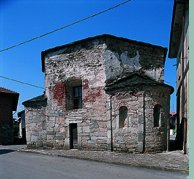- Abitanti:
Inhabitants number :2260
Superficie
Surfacekmq: 8,38
Altitudine sul mare:
Altitude:289 m
Denominazione degli abitanti:
Inhabitants:cureggesi
Altre località:
Towns:Marzalesco,
Cascine Enea - Cascine:
Farms: Cappuccina,
Colombera,
Pianazze,
Prati,
Rama,
Stornini
Festa patronale:
Patrons:S. Rocco (16/08)
Telefono:
Phone: 0322
(Municipio/ Town Hall 0322 83 91 00)
Codice Postale:
Postal code: 28060 - Sito internet:
www.comune.
cureggio.no.it - Mail:portale@comune.
cureggio.no.it
Sito nell’area circostante Borgomanero, Cureggio è un borgo di età romana, l’antica Curegium: sono state, infatti, rinvenute sette lapidi d’epoca romana. Appartenne al Comitato di Pombia, ai conti di Biandrate e, dal 1202, al Comune di Novara.
Cureggio is a roman town and it was named “Curegium”. Here, in fact, there were found 7 stones of roman times. It belonged to the Comitato di Pombia, to Biandrate and then to Novara.
Chiesa Parrocchiale La parrocchiale, dedicata a Santa Maria Assunta, è citata per la prima volta nel 1013 come sede pievana; la costruzione potrebbe quindi risalire alla seconda metà dell’XI secolo. Il campanile si pensa risalga al 1100-1125. La struttura muraria dell’edificio religioso è composta da ciottoli di fiume e mattoni, disposti a spina di pesce. Già eretta a tre navate con absidi, suddivise da pilastri a sezione rettangolare, fu abbondantemente modificata e ampliata nel XVI secolo, con l’aggiunta di un pronao in facciata. Al suo interno si possono ammirare affreschi del XV secolo.
Parish churchThe parish church of St Maria Assunta is mentioned for the first time in 1013 as the parish seat. The building in this case could date back to the second half of the 11th century. The bell tower is probably from 1100-1125. The masonry of the religious building consists of rounded stones and bricks arranged in a herringbone pattern. Originally consisting of three naves with apses, divided by rectangular pillars, it was heavily alterated and extended during the 16th century, with the addition of a vestibule on the façade. In the interior it can admire frescoes from the 15th century.
|
|
|
La Parrocchiale dell'Assunta e il campanile / Parish church |
|
Il Battistero / The baptistery |
The baptisteryThe baptistery is located opposite the parish church, in the main square. Most probably it is the baptistery of the ancient parish church already mentioned for the first time in 1013 and later in 1132. It has an octagonal plan; on the exterior walls are four apses, or large niches, on each of which can be seen a single light window with can be seen a single light window with splays and stone archivolt, which were patched up during restoration in the 16th century. In the interior is an interesting fresco representing the Madonna enthrones with Child and two Saints.
|
Chiesa di San Pietro in
MarzalescoDi origine romanica è l’antica chiesa dedicata
a San Pietro, situata nella frazione Marzalesco. é a
navata unica con abside semicircolare ed è orientata.
Nel corso dei secoli l’edificio religioso ha sub“to
innumerevoli modifiche strutturali: nel Seicento la navata centrale
è stata sopraelevata, sono state aperte nuove finestre
sui muri laterali e ampliate le finestre originali, sono stati
rifatti il tetto e il pavimento; successivamente sono state
aperte tre finestrelle sul lato sud e una in facciata; nell’Ottocento
è stata costruita la sacrestia e nel 1960 la chiesa è
stata intonacata interamente. Di pregio, all’interno,
gli affreschi del XV secolo che decorano le pareti. Il campanile
è a base quadrata, con finestrelle a feritoia, è
databile al 1050-1100.
St Pietro in Marzalesco churchThe ancient church of St Peter, of romanesque origins, is situated in the hamlet of Marzalesco. It has a single nave with semicircular apse and is east-west orientated. During the centuries the religious building underwent many alterations: in the 17th century the central nave was raised, additional windows were opened on the side walls and the original windows enlarged, the roof was remade as well as the floor; later three small windows were opened on the southern wall and one on the façade; in the 19th century the sacristy was built and in 1960 the church was entirely plastered. In the interior valuable frescoes from the 15th century decorate the walls. The belltower, dating back to 1050-1100, has a square base and small slit windows. |
St Bernardo da MentoneThe church stando close to the Enea farmhouses, a small and ancient settlement located on the road leading from Borgomanero to Romagnano Sesia. It was built in 1709 as can be seen from the inscription on the external wall of the apse. The building has a single nave with a valuable polychrome marble altar. At the back is an impressive icon representing the patron saint Bernardo with the virgin and Saints. IN front of the external façade is a portico with three arches. It is in the Baroque style, decorated with stuccoes and moulded cornices.
Riserva
Naturale Orientata delle BaraggeLa Riserva Naturale Orientata delle Baragge è stata istituita
nel 1992 al fine di proteggere questa particolare area (Baraggia)
della pianura piemontese che un tempo si estendeva da Biella
fino al Ticino. La Baraggia del Pian del Rosa,
interessa i comuni di Cavallirio, Cavaglio d’Agogna, Cureggio,
Fontaneto d’Agogna, Ghemme e Romagnano Sesia. é
una natura “particolare” quella che si incontra
all’interno della riserva, propria dei terreni baraggivi.
Possiamo trovare la Molina Cerulea, il brugo o Calluna, le graminacee,
la ginestra, e non è raro imbattersi in piante acquatiche
che lambiscono piccole zone paludose formatesi in seguito alle
piogge primaverili e non assorbite dal terreno troppo impermeabile.
Piccoli boschi di betulle, pioppi tremuli, pini silvestri e
ginepri completano la caratteristica vegetazione della zona.
Numerosi uccelli si sono adattati: infatti sono ben 167 le specie
censite, alcune sono stanziali, altre di passo. Da citare la
cicogna bianca e la cicogna nera, il picchio rosso minore, la
colombella, la capirossa ecc... Si è notata spesso la
presenza della volpe, della lepre e del capriolo, assolutamente
protetti.
|

